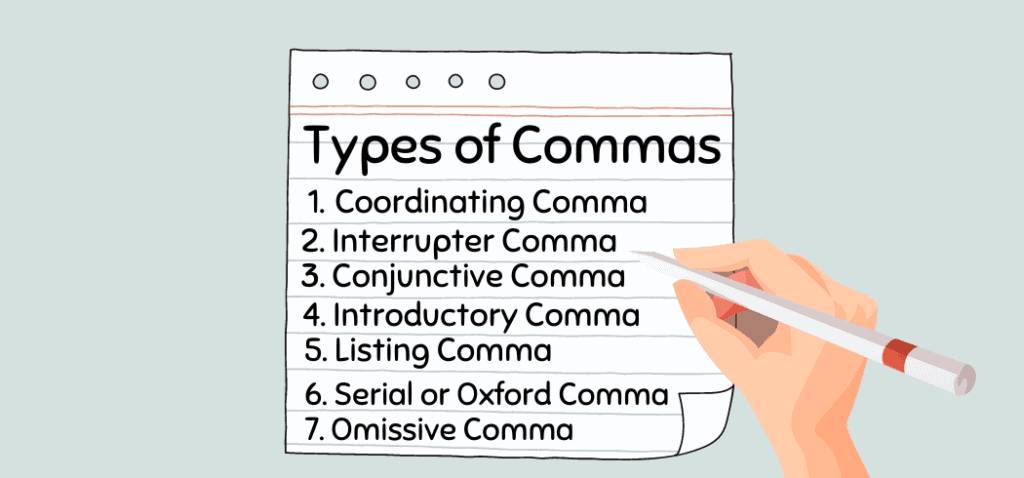Every grammarian you speak to will label commas differently, but all will agree on the rules of their use. Commas are essential to help create organization and understanding of complex sentences, but occasionally comma rules can be confusing to new writers.
Sometimes breaking down these rules into labels help give names to each type of comma. These names are sometimes easier to remember. I’ve broken down the six main rules of commas with examples and put them into seven comma types to help you make sense of each.
Types of Commas

There are quite a few discussions concerning how many types of commas there are. Some grammarians claim there are four types of commas, while others feel they can be categorized into more. There are no actual names of commas, but it is easiest to name them in relation to the rules for commas.
I personally feel that comma categorization should be related specifically to comma rules. Commas are required to help introduce material, offset information, organize lists, and separate other pertinent information within written text. This makes it easier for new writers to remember their use.
#1. Coordinating Comma
A comma must be placed before a coordinating conjunction that joins together two independent clauses. Compound and compound-complex sentences create a more sophisticated text, but they must be properly punctuated with commas when joined together.
For example:
- This winter, we plan on traveling to see family, and we will most likely road trip in order to see the sites along the way.
#2. Interrupter Comma
Sentences are often interrupted with unnecessary words, subordinate clauses, or descriptive phrases that add detail to the sentence. They need to be bracketed by commas before and after to indicate a pause or break in the flow of the sentence.
The sentence may look jumbled or confused to the reader without the commas. The information located between the commas is generally not needed for the overall understanding of the sentence but does provide detail and interest.
For example:
- My new position started last week, after I trained in a replacement, and is much more organized and less stressful.
#3. Conjunctive Comma
A conjunctive adverb can be located at the beginning or in the middle of a sentence and must be separated from the rest of the sentence with commas. Conjunctive adverbs are used to introduce surprising information or work to change the subject. They include words such as therefore, thus, however, and furthermore.
For example:
- Nonetheless, she was excited to be a part of the next graduating class.
- There wasn’t much he could do to fix the situation, however, but he was going to try.
#4. Introductory Comma
When a sentence begins with an introductory clause or phrase that cannot stand as a complete sentence, it must be followed with a comma. This provides an introduction to the rest of the information in the sentence.
For example:
- If Megan is granted the scholarship, she plans to use it to cover her college tuition for the first two years.
#5. Listing Comma
Commas are used to separate three or more words, phrases, or clauses listed in a sentence. A comma does not have to be placed between the final item and the preceding item in the series, but sometimes it is preferred. This final comma is called a serial, or Oxford comma, and I explain it in #6.
For example:
- I need you to run to the store and pick up eggs for tomorrow’s breakfast, flour for the pie crusts and coffee to serve with dessert.
#6. Serial or Oxford Comma
The serial comma, also known as the Oxford comma, is a comma that separates the last two items in a list. There is a bit of controversy over its use, with some grammarians saying it isn’t needed, while others insist on its use to avoid confusion or comprehensive errors in a simple series.
For example:
- The meals included on the trip were breakfast, lunch, a small afternoon snack and dessert.
Without the Oxford comma, one might wonder if the afternoon snack and dessert go together or if they are separate from one another. With the Oxford comma added, the sentence becomes more concise:
- The meals included on the trip were breakfast, lunch, a small afternoon snack, and dessert.
Let’s look at another example:
- My parents invited us, the neighbors, Joe and Mary, to dinner tomorrow.
Are Joe and Mary the neighbors, or are they separate guests invited to dinner along with the neighbors? If you get into the habit of using an Oxford comma, your readers will know the difference.
For example:
- My parents invited us, the neighbors, Joe, and Mary, to dinner tomorrow.
#7. Omissive Comma
Coordinating commas join two independent clauses together using a coordinating conjunction. An omissive comma can replace an omitted coordinating conjunction (such as and, but, or, so, or nor) to join together two independent clauses.
For example:
- I asked him to take the dog for a walk, [but] he forgot, and she was up all night.
A comma replaces the word “but” without changing the meaning of the sentence.
- During summer break I exercise every day, [and] I walk three miles.
In this sentence a comma replaces the word “and” without changing the meaning of the sentence.
Let’s Review
Commas are used to help provide clarity to complex sentences and work to conjoin or add information to an independent clause. They are necessary for reading comprehension and flow of writing ease. Although they are one of the most important punctuation marks, they are also often misused.
Although there are no technical labels for commas, they can be easily named to describe the rules they follow. These seven types of commas provide the information you need to help remember their use in a simple manner.
